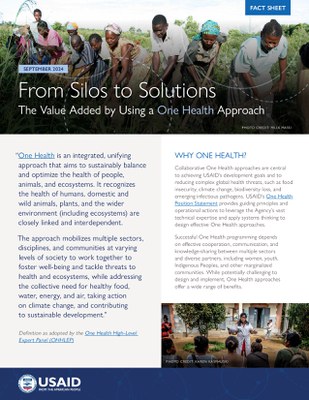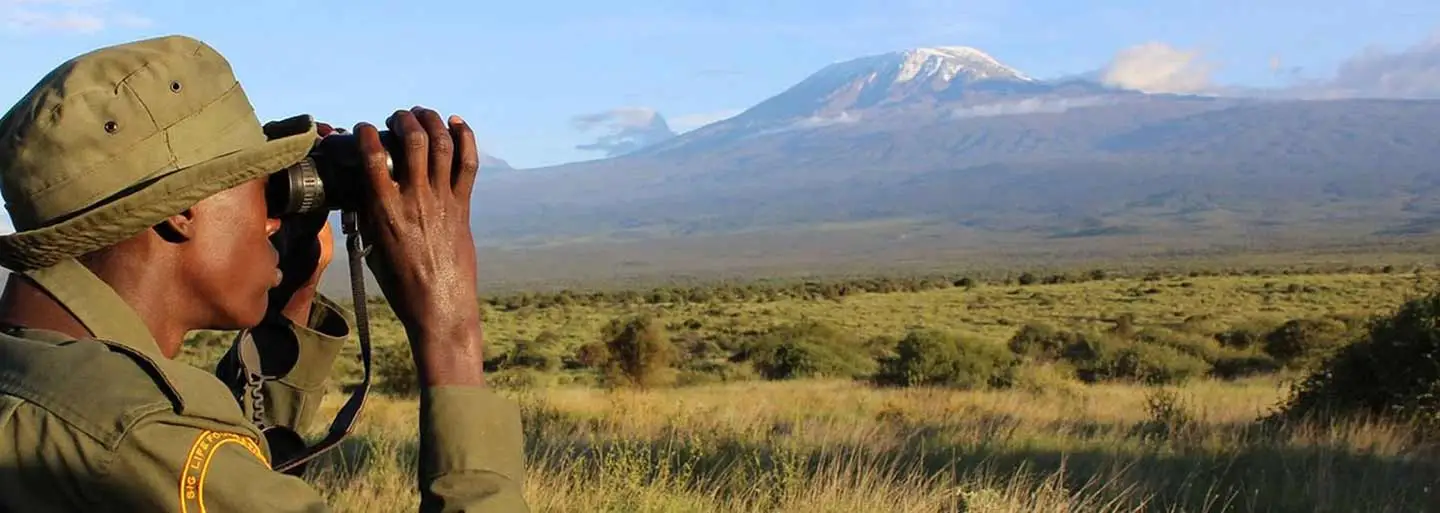From Silos to Solutions: The Value Added by Using a One Health Approach

“One Health is an integrated, unifying approach that aims to sustainably balance and optimize the health of people, animals, and ecosystems. It recognizes the health of humans, domestic and wild animals, plants, and the wider environment (including ecosystems) are closely linked and interdependent."
"The approach mobilizes multiple sectors, disciplines, and communities at varying levels of society to work together to foster well-being and tackle threats to health and ecosystems, while addressing the collective need for healthy food, water, energy, and air, taking action on climate change, and contributing to sustainable development.” - Definition as adopted by the One Health High-Level Expert Panel (OHHLEP)
Why One Health?
Collaborative One Health approaches are central to achieving USAID’s development goals and to reducing complex global health threats, such as food insecurity, climate change, biodiversity loss, and emerging infectious pathogens. USAID’s 2024 One Health Position Statement provides guiding principles and operational actions to leverage the Agency’s vast technical expertise and apply systems thinking to design effective One Health approaches.
Successful One Health programming depends on effective cooperation, communication, and knowledge-sharing between multiple sectors and diverse partners, including women, youth, Indigenous Peoples, and other marginalized communities. While potentially challenging to design and implement, One Health approaches offer a wide range of benefits, including:
Enhanced capacity to address complex challenges
By working together at the policy, research, and/or programmatic level, cross-sectoral teams can capitalize on expertise across a variety of sectors. They can also access a wide array of tools to identify and amplify opportunities to collaborate and manage complex trade-offs. For instance, years of unsustainable fishing and aquaculture have degraded Madagascar’s marine resources, increasing poverty among fishing communities. Recognizing the need for an interdisciplinary approach, USAID/Madagascar’s Nosy Manga activity (2022-27) brings together public and private sector partners with expertise in sustainable aquaculture, governance of marine protected areas, business development, and community engagement to promote responsible seaweed and sea cucumber farming, support community services including health care, reduce pressure on marine resources, and alleviate poverty.
Sharing knowledge and resources across sectors
One Health provides a framework that fosters trust and builds relationships for long-term, efficient information exchange and enhanced coordination to meet common objectives. For example, a One Health approach to mitigate the spillover of zoonotic pathogens can mobilize not only the public health sector’s disease surveillance systems but also real-time data on wildlife health and possible underlying ecosystem health drivers. Applying a systems-based lens to complementary datasets can lead to earlier detection and, ideally, help prevent disease outbreaks at their source.
Resource savings
The One Health approach can save resources and achieve results more cost-effectively. For instance, a World Bank analysis projects that a One Health approach to preventing pandemics globally may cost up to $11.5 billion per year, significantly less than the estimated annual $30 billion cost of managing pandemics. One Health collaboration can also save costs and prevent duplication of efforts at the project level. In sub-Saharan Africa, researchers studying Rift Valley fever estimated that joint animal-human serum testing would save 35 percent in total costs compared with separate testing by reducing transportation costs and the size of sampling teams.
Unified voice and message
One Health provides a platform to discuss and communicate concerns about complex challenges across sectors from local to global scales. Effective messaging, in turn, can increase political support and resource allocation for integrated solutions. Optimizing One Health communications requires strong networks between scientists and policymakers. One Health teams that include experts like economists and sociologists can better interpret and convey societal perspectives that resonate with policymakers.
Examples of One Health in Context
Documenting how integrated One Health projects provide greater benefits compared with single-sector or siloed approaches can be technically challenging. The following examples from within and outside USAID highlight the value added of One Health’s capacity to advance USAID priorities, such as improving health, strengthening food and water security, conserving biodiversity, and mitigating climate change.
Antimicrobial resistance (AMR)
The World Health Organization has promoted a One Health approach to address antimicrobial resistance, a complex, multifaceted challenge with significant public health impacts. For example, the WHO is promoting the three-sector (human health, the food chain, and the environment) Tricycle surveillance framework to address extended-spectrum beta-lactamase-producing Escherichia coli (ESBL-EC), a pathogen that causes severe infections in humans and is resistant to many beta-lactam antibiotics. Countries are advised to improve surveillance by testing for the pathogen in the feces of pregnant women, the blood of patients with bloodstream infections, water specimens from areas near wet markets, human wastewater, and chicken droppings from wet markets and slaughterhouses. A 2023 study of the Tricycle protocol noted that 19 countries are at various stages of implementation, with researchers finding that this integrated framework fosters the type of multi-sectoral collaboration that is crucial to understanding the extent of antimicrobial resistance globally and informing containment strategies. Value added of One Health approach: enhanced capacity to address complex challenges; sharing knowledge and resources across sectors.
Biodiversity conservation
Health in Harmony, a non-profit organization working with communities in rural Borneo, identified the need to raise cash for healthcare costs as a driver of deforestation. They implemented a cross-sectoral approach that provides high-quality, affordable healthcare in exchange for local communities curtailing their illegal logging activities and implementing conservation efforts like reforestation. An analysis of environmental impacts found that deforestation decreased by ~70 percent over a 10-year period around communities working with Health in Harmony compared with a modeled control. In addition, Health in Harmony treated over 28,000 patients at their clinics over the same time period. Value added of One Health approach: enhanced capacity to address complex challenges and resource savings.
Combating Emerging Infectious Diseases
Poultry production in Southeast Asia has been challenged by various animal disease threats, including highly pathogenic avian influenza (HPAI, also referred to as “bird flu”) and other emerging zoonotic and transboundary animal diseases. To mitigate the risk, emergence, and spread of new pandemic disease threats across Southeast Asia, the Food and Agriculture Organization of the United Nations Emergency Centre for Transboundary Animal Diseases (FAO-ECTAD) has implemented the One Health approach through a program that aims to improve coordination across sectors, strengthen regional epidemiology capacities and networks, and fortify evidence-based risk management along the livestock production and market chain. With USAID support, FAO-ECTAD applied the One Health approach to help specific partner countries–including Cambodia, Vietnam, and others–to prevent and control the emergence and spread of avian influenza and other zoonotic diseases while enhancing farmer profitability, food security and building resilient rural livelihoods and healthy communities. Value added of One Health approach: enhanced capacity to address complex challenges; sharing knowledge and resources across sectors; unified voice and message.
Water security and gender equality
The arid and semi-arid lands (ASALs) are critical to Kenya’s economy, covering 89 percent of Kenya’s land area, with 70 percent of the country’s livestock herds and more than 90 percent of the wildlife that supports the tourism industry. The population is highly vulnerable to the effects of climate change, which are predicted to become more acute in the future. The combination of historical marginalization, population growth, and environmental shocks has increased competition for resources, triggered conflict, and perpetuated poverty, leaving more than 1.6 million people experiencing high levels of acute food insecurity and only 55 percent of the population with access to safe drinking water in the USAID Kenya Sustainable Transformational and Accessible Water Interventions' (STAWI) nine target counties. To achieve lasting water security in the ASALs, STAWI is taking an Integrated and Inclusive Water Security approach, working across built and natural systems, in both rural and urban areas, to connect WRM, water services, and water for production, while taking a risk-aware, facilitative approach to strengthening enabling governance and financial structures. Locally designed and led approaches, and empowerment of women and youth, are at the center of implementation. Value added of One Health approach: enhanced capacity to address complex challenges; leveraging knowledge and resources across sectors.
Treatment and control of neglected tropical diseases
In Tanzania, researchers implemented a One Health delivery platform that combined control programs for two neglected tropical diseases (soil-transmitted helminthiases [worms] and rabies) within adjoining clinics. Benefits of this One Health approach included cost savings (33 percent lower cost per deworming dose and 16 percent lower cost per rabies vaccination, primarily due to shared transportation costs) and time savings for community members from getting both control strategies in one place (33 percent less time for one person with a dog) rather than separately. Communities familiar with the success of the rabies vaccination trusted and were more willing to take part in the treatment for soil-transmitted helminthiasis. An important co-benefit was increased collaboration and stronger relationships between traditionally siloed national ministries. Value added of One Health approach: resource savings.



